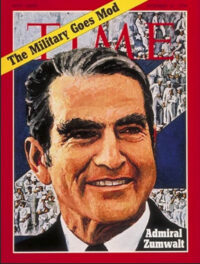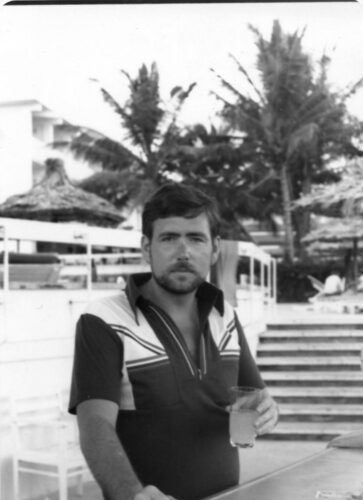Z-Grams

Admiral Elmo “Bud” Zumwalt was in the middle of a change in an old institution that in it’s time had some of the same reverberations we are experiencing today. The impact was profound on those who had served the old system as the one today. The Professional Organization to which some of us still belong had members who had lived the transition. One afternoon at the famous Willow Restaurant our 92-year-old pal Mac told us about the depth of it. We assumed that since he had been selected for Flag rank he had been the Director of Naval Intelligence.
He laughed and corrected us. He had been at the Defense Intelligence Agency when Bud swept back from duty in Vietnam. He was a United States Navy officer and the youngest person to serve as Chief of Naval Operations. His service in Vietnam had included adapting a fighting force from a high-seas orientation to one capable of effectively fighting in the brown waters close-in to the shore and up the rivers and estuaries where the enemy fought.
His job, as he understood it, was to refurbish a Navy to deal with a nuclear-armed Russia after a smaller war in SE Asia. That one was not over when he took command, but the decision was made to change things. And make the change dramatic.
He assumed duties as Chief of Naval Operations and was promoted to the rank of full four-star Admiral on July 1, 1970. The War he left was not over. The incursion into Cambodia from South Vietnam which he had helped plan was in progress. It was advertised as an offensive against North Vietnamese sanctuaries on the Ho Chi Minh Trail, code-named Operation ROCK CRUSHER. The American withdrawal from South Vietnam was proceeding despite unease over the enemy’s strength inside Cambodia. President Nixon relaxed the restrictions on moving against the bases inside Cambodia. American and allied Vietnamese forces began large-scale offensives in Cambodia.
So, withdrawal of ground forces was in progress. But Bud was charge with leading a new offensive when he assumed his new duties at the Pentagon. His mission as CNO was not to “shake things up,” but rather change them fundamentally. In order to do so, he quickly began a series of actions targeting ‘racism and sexism’ in the Navy he intended to transform. The new policies were disseminated in Navy-wide communications that became known as “Z-grams.”
The Old Salt remember them vividly. Some included dramatic changes in personal appearance. He authorized beards (sideburns, mustaches, and longer groomed hair were also acceptable) and introduced beer-dispensing machines to barracks. Not all of these were well-received by senior naval personnel. In fact, directives to reduce discrimination against women and racial minorities were adamantly opposed by some.

(One of us displays facial foliage on a 1980 port visit to Pattaya Beach, Thailand, in 1980 while assigned to fighter Squadron 151, embarked in USS Midway (CV-41). He got orders to Korea to join the staff of US Forces assigned there to defend the Armistice that ended the Police Action that halted a war there. Upon arrival he was directed to shave.)
The Z-Grams came up this morning, as news reports ready us for the one-year anniversary of the Russian invasion of Ukraine tomorrow. Other tidings this morning reflect a dramatic change in global balance. China’s President Xi is in Moscow to offer assistance to Mr. Putin. This appears to reflect the challenge Bud Zumwalt confronted in reshaping his Navy’s effort to replace large numbers of aging World War II-era ships that remained in the inventory. The plan was called “High-Low.” It attempted to balance acquisition of high-end, nuclear-powered vessels with low-end, cheaper ones that could be bought in greater numbers.
That strategy was opposed by people like Hyman Rickover, now known as the Father of the Nuclear Navy. He and his atomic visionaries preferred buying a few major ships of world-class design to to buying a fleet of ordinary ones. The organizational tension spanning the variety of changes ranged from whether to shave in the morning to the christening of the Oliver Hazard Perry (FFG 7) class of guided missile frigates to balance the advent of the advanced Arleigh Burke-class (DDG 51) destroyers.
There is talk of how many warships the Navy will de-commission this year in order to clear the waterfront for new technology and enhanced capability. We are outnumbered at the moment, as our newest nuclear-powered aircraft carrier- USS Ford (CVN-78)- is the “first new carrier design in 40 years.” She was laid down in 2009 and there is some debate about whether she is ready to deploy fourteen years later.
You can already see one of the issues, and we will see how this works out. There is discussion about whether a new Chinese force is ready to fight. There is more discussion about whether our Force is equipped to deal with a new sort of threat. There is no one prepared to send the equivalent of Admiral Zumwalt’s Z-Grams to galvanize the transformation at the moment.
You can see the nature of the challenge. The newest carrier is named for President Gerald R. Ford, a known male. Ships are traditionally ‘identified’ at christening as “she.” There had been discussion of using something more inclusive, but recent experiments in LatinX designation have produced mixed results. There is apparently an emergency meeting in progress on the use of correct pronouns that will fix everything.
This morning, anyway.
Copyright 2023 Vic Socotra
www.vicsocotra.com
